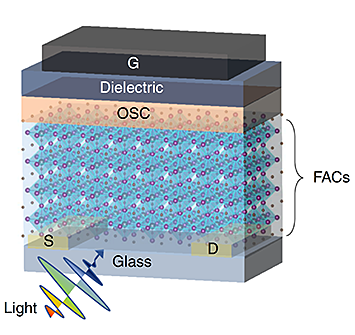Bringing to Light: Dynamics in Phototransistors
Scientists designed and investigated a new tunable phototransistor with promising properties
November 30, 2019
 enlarge
enlarge
Schematic of phototransistor. G, S, and D denote the gate, source, and drain respectively. OSC is an organic semiconductor layer, while FACs is the mixed-cation mixed-anion perovskite layers. Image credit: Nature Communications 10, 4475 (2019)
The Science
Scientists demonstrated on-demand tunability of optoelectronic phototransistors.
The Impact
Metal-halide perovskites (MHPs) offer great opportunities to revolutionize large-area photodetection technologies. This study offers new insights into photocarrier dynamics and a pathway to tunable sensors.
Summary
Photodetection and photosensing are two scientific terms that seem like they might never cross paths with you in your everyday life, but this is not true. In many applications in our everyday lives, we use sensors or detectors that capture photons, little particles all light is made of. Some of these technologies can be found in optical communications, imaging systems such as cameras, environmental detection, as well as medical diagnostics. Among different types of photodetectors, phototransistors are of notable interest due to their potential to achieve highly tunable photogain—the efficiency with which they capture light when combined with a variety of new intrinsic semiconductors. An active component in detection, phototransistors are not only capable of operating under different modes but also reducing the complexity of the readout circuitry required to build an actual detector.
A special class of materials called metal-halide perovskites offer great opportunities to revolutionize large-area photodetection technologies due to several benefits, including their high absorption coefficients—the effectiveness with which they collect photons—and simple processability. However, the successful extraction of photocarriers from perovskites and their conversion to electrical signals remain challenging due to the interdependency of photogain and dark current density.
A team of scientists designed and investigated a hybrid hetero-phototransistors by integrating perovskites with organic semiconductor transistor channels and found that this new design offers high photogain values. The team studied the new device design using a multitude of experimental methods, including a technique called grazing-incident wide-angle x-ray scattering (GIWAXS) using the Complex Materials Scattering (CMS) beamline at the National Synchrotron Light Source II (NSLS-II)—a Department of Energy (DOE) Office of Science User Facility located at DOE’s Brookhaven National Laboratory.
The combined results of all their studies offered improved insights into photocarrier dynamics and their dependence on material properties and operational conditions. The results also provided essential knowledge for a more thorough understanding of designing and developing perovskite-organic based optoelectronic devices and systems.
Download the research summary slide
Contact
Yen-Hung Lin
University of Oxford
yen-hung.lin@physics.ox.ac.uk
Thomas D. Anthopoulos
King Abdullah University of Science and Technology (KAUST)
thomas.anthopoulos@kaust.edu.sa
Henry J. Snaith
University of Oxford
henry.snaith@physics.ox.ac.uk
Publications
Y. –H. Lin, W. Huang, P. Pattanasattayavong, J. Lim, R. Li, N. Sakai, J. Panidi, M. J. Hong, C. Ma, N. Wei, N. Wehbe, Z. Fei, M. Heeney, J. G. Labram, T. D. Anthopoulos, H. J. Snaith, “Deciphering photocarrier dynamics for tuneable high-performance perovskite-organic semiconductor heterojunction phototransistors”, Nature Communications 10, 4475 (2019). DOI: 10.1038/s41467-019-12481-2.
Funding
This project was funded by EPSRC, Engineering and Physical Sciences Research Council grants, EP/M005143/1 and EP/P006329/1 and the King Abdullah University of Science and Technology (KAUST). This work used CMS beamline of the National Synchrotron Light Source II (NSLS-II), a U.S. Department of Energy (DOE) Office of Science User Facility operated for the DOE Office of Science by Brookhaven National Laboratory under Contract No. DE-SC0012704.
2019-17176 | INT/EXT | Newsroom









